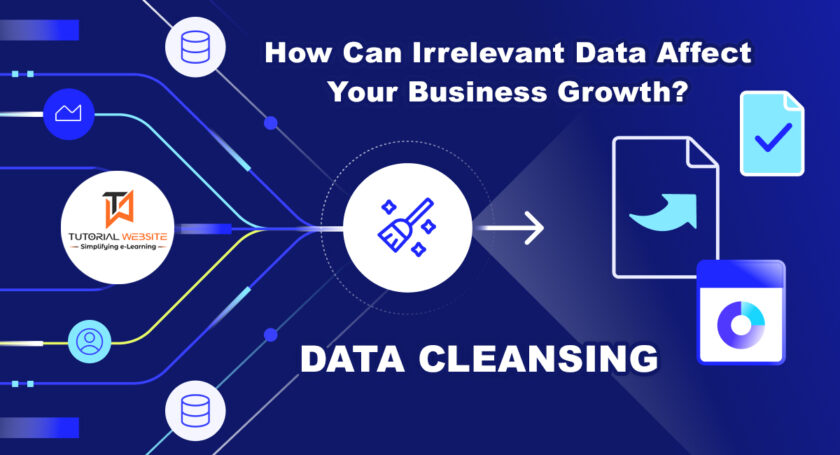The most important aspect of any business intelligence strategy is data quality and hence it is important to know how irrelevant data can affect your business growth. It’s one thing to build systems to collect and distribute data; however, if the data is corrupted, it’s useless.
What is data cleansing?
Data cleansing, scrubbing, or appending is a technique for updating or removing erroneous and inaccurate data. This procedure is critical and should be highlighted since incorrect figures can lead to erroneous decisions, conclusions, and analyses, especially when large amounts of big data are involved. Scrubbing data is a critical task for any business. To make the greatest possible business decisions, it’s critical to use the proper data, clean it up, and evaluate it. Over time, individuals and corporations acquire a lot of personal data! You could, for example, change your address or name ten times in ten years and then change it again!.
It is the process of looking through all of the data in a database and eliminating or updating any missing, erroneous, poorly structured, duplicated, or unnecessary information. Big data can become cluttered, duplicated, and difficult to handle over time. The process includes:
- Fixing or removing incorrect data
- Identifying incorrect or irrelevant data
- Organizing data
- How can irrelevant data affect your business growth?
For the people of the United Kingdom, data quality is a crucial concern. Despite the fact that 99 percent of firms have a data quality policy and also data cleansing companies like Eminenture remain in the top search many admit to still having data issues, with 86 percent believing their data is erroneous in some form. Irrelevant data wreaks havoc on the entire business growth of an organization and eventually leads to higher maintenance costs, increased churn rates, invalid reports, and loss in revenue.
- Incorrect to correct data- road to organizational success
Your “ace of spades” is relevant, actionable data. However, before you play that card, you must first have it in your deck. You need to have a quick reply in order to make your company take data-driven corporate decisions.
- Organizing data
The process of scrubbing facts also includes organizing data, your organized figures contain the keys to managing your organization’s most valuable assets. An organized and good database allows your company to establish baselines, benchmarks, and goals to keep moving forward.
Techniques of data cleansing
Here are a few techniques to make sure your data is ready to go
- Remove irrelevant data
Examine your data thoroughly to determine what is relevant and what you may not require. Remove any data or observations that aren’t pertinent to your requirements later on. If hashtags, URLs, emoticons, HTML tags, and other items aren’t absolutely important for your research, you should consider removing them.
- Validating data accuracy
Validate the accuracy of your information after you’ve cleaned up your existing database. Look into data-cleaning solutions that can be used in real-time and invest in them. To increase the accuracy of testing, some methods use artificial intelligence (AI) or machine learning.
- Deduplicate data
Deduplication is essential for guaranteeing efficient and accurate business processes. It entails removing duplicates and isolated variants of the same data, leaving only one or as few golden copies as possible.
- Fix structural errors
Misspellings, inconsistencies in name standards, wrong capitalization, erroneous word usage, and other structural faults are examples of structural errors. While these flaws may be obvious to humans, most machine learning algorithms will miss them, resulting in distorted findings.
Steps in the data cleansing process
Step 1: Inspection and Profiling- You must review and audit facts to determine their quality and identify flaws that must be addressed. This step sometimes includes data profiling, which encompasses recording relationships between data items, assuring data quality, and producing statistics on data sets to aid in the detection of errors, discrepancies, and other problems.
Step 2: Cleaning and verification– This is at the core of the cleansing process, when figure errors are fixed and inconsistent, duplicate, and redundant data are addressed. The data should be reviewed once it has been cleaned to confirm that it is clean and meets internal data quality rules and standards.
Step 3: Reporting- To emphasize data patterns and success, the results should be shared with IT and business executives.
Tools used for data cleansing
With most companies relying on data, companies use their in-house data cleansing team or outsource their data needs to companies. Here is the list of some of the top tools used by companies to clean their data:
- OpenRefine
- Drake
- Tibco Clarity
- DemandTools
- Cloudingo
Final thoughts
According to a Medium article about cleaning up your database, precisely organized data can help your staff make the most of their time at work. Hence, no doubt irrelevant data can affect your business growth, whereas understanding data quality and the tools you’ll need to collect, manage, and convert data is a critical first step toward making smarter business decisions. This vital procedure will help your company build a data culture.
Vikas Maurya is a professional blogger and Data analyst who writes about a variety of topics related to his niche, including data analysis and digital marketing.
